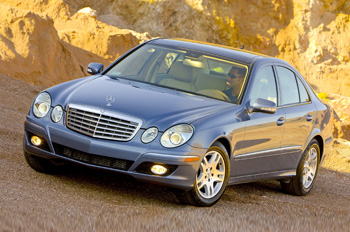
LAS VEGAS – Would someone in the market for a luxury sedan pay an extra $1,000 for 40% better fuel economy? Heck, yea – at least if performance isn’t sacrificed.
That’s the too-good-to-believe story with Mercedes-Benz’s new E320 Bluetec, the latest diesel-powered variant of the seminal E-Class sedan. The ’07 E320 Bluetec, at $52,325, costs a measly $1,000 more than the E350, the same car with a gasoline-burning 3.5L DOHC V-6.
That extra grand buys Bluetec, the first stage of exhaust-aftertreatment technology that is Mercedes’ assault on tight new federal and California emissions standards that ultimately will result in the company offering 50-state-compliant diesels beginning in 2008.
But for now, it buys subcompact-car fuel economy figures: 27 mpg (8.7 L/100 km) in city driving and a tasty 37 mpg (6.4 L/100 km) on the highway.
That’s a no-brainer measured against the gasoline-powered E350’s 19 mpg (12.4 L/100 km) city and 27 mpg (8.7 L/100 km) highway figures. Or consider this: An automatic-transmission Honda Civic squeezes out just three miles (4.8 km) more out of a gallon of gas vs. the E320 diesel.
And Mercedes’ new 72-degree, all-aluminum 3L DOHC V-6 turbodiesel is as quiet as the Detroit Tigers’ World Series bats.
Credit goes to the high-tech piezohydraulic fuel injectors that eradicate the compression-ignition clatter to the point where the diesel’s idle is indistinguishable from the usual mechanical gnashing of gasoline-engine ancillaries.

And a tidy encapsulation package soaks up whatever radiated noise does make it through the alloys, such that pedestrians standing beside the E320 Bluetec won’t be troubled in the least.
But noise, vibration and harshness parity with a gasoline engine is only half of the vital performance-improvement litmus test diesels must pass to steal as much as the 15% market share some proponents predict by 2010.
For American drivers, if it doesn’t go, it’s not likely to sell.
The 0-60 mph (96 km/h) times underscore just how little consumers give up with Mercedes’ excellent new diesel.
Yes, the E320 CDI scampers to 60 mph in just a tenth of a second less than the gasoline V-6, but it’s also just 1.2 seconds off the 5.4-second pace of the V-8-packing E550, which many consider a pretty thunderous specimen.
All three E-Class variants have electro-nursemaids that tsk-tsk at 130 mph (209 km/h), and the 3L diesel has no trouble ramming the E320 CDI Bluetec to that velocity. We know, because we did.
At 208 hp, the 3L V-6 turbodiesel gives up 60 hp to its gasoline 3.5L V-6 alternative, but the acceleration times prove there’s more to this race than measured horsepower.

The turbodiesel churns out a thumping 400 lb.-ft. (542 Nm) of torque from 1,600-2,400 rpm – the giant 142 lb.-ft. (193-Nm) advantage it enjoys over the gasoline V-6 being the acceleration equalizer, particularly considering the reasonable 80 lbs. (36 kg) of extra weight the E320 Bluetec must overcome.
If there’s anything sacrificed, it’s a disconcertingly dead feel when the throttle’s pinned to accelerate from a dead stop. The turbocharger lag lasts the briefest of moments. Yes, there’s the fanciest of new, variable-nozzle turbos spinning out its heart on your behalf, but it’s still a turbo, and turbos need a second, thanks.
And the tight 4,600-rpm redline takes some acclimation, too, if for no other reason than this engine feels like it would happily rev to six grand if it were possible to make all that complicated combustion magic work at that engine speed.
The standard 7-speed automatic doesn’t care about the redline – it just goes about its business (usually) selecting the necessary gear and shift strategy. We did make liberal use of the automatic’s outstanding, intuitive Touch Shift sequential manual shifting mode to extract the most-responsive shifting, however.
Other than the Bluetec badging, there’s nothing particularly unique about the E320 Bluetec to reveal you’re driving the economy car of luxury sedans. It shares the refreshed front and rear fascias and, more noticeably, warmer new interior materials and revised steering wheel common throughout the ’07 E-Class range.
And yes, the standard 16-in., economy-enhancing tires are squidgier than the more peformance-oriented 17s and 18s available for gasoline E-Classes. That’s unlikely to bother most diesel buyers, who are assumed to be more interested in long-distance comfort than tackling Interstate on-ramps.
We’d like to see Mercedes quickly link up its 4Matic all-wheel-drive system with this superb new diesel. But for now, the E320 Bluetec, we predict, will once and for all dispel any lingering doubts about new-generation diesels’ ability to make a serious impact in North America.
For $1,000, any potential E-Class buyer who doesn’t go Bluetec must be holding stock in Big Oil.



